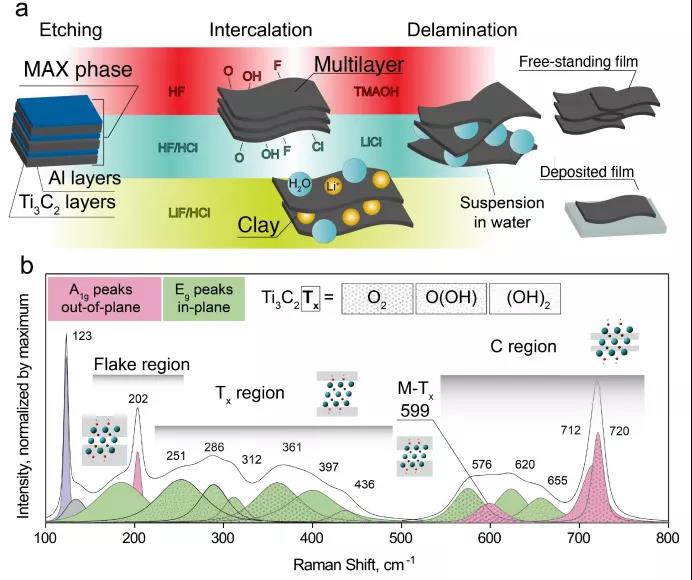
hotline:
17715390137
Tel/Wechat:
18101240246 (Technology)
0512-68565571
Email:mxenes@163.com (Sales Engineer)bkxc.bonnie@gmail.com
Scan the code to follow or search the official account on WeChat:
2D Materials Fronrier After paying attention,
click on the lower right corner to contact us,
Enter enterprise WeChat.
Professional Services Online

Raman spectroscopy has extensively studied many different types of two-dimensional materials. This fast, non-invasive, and sensitive method can even record the spectra of many single sheets of two-dimensional material. It is one of the most useful tools for analyzing two-dimensional materials. Although MXenes is a very large two-dimensional transition metal carbonitride family, there is not much Raman research on this series of materials.
Achievements
Recently, Drexel University ‘s Yury Gogotsi professor in the top international journal Chemistry of Materials published entitled "Raman Spectroscopy the Analysis of Structure and Surface Chemistry of Ti 3 C 2 T the X- MXene" papers. Reports on the most widely used and most important MXene--Ti 3 C 2 T x system research to date . After synthesizing materials by different methods, the results show that the Raman spectrum of Ti 3 C 2 T x is not only affected by the components and surface groups, but also by the type and stacking of intercalation. Since the plasmon resonance peak of Ti 3 C 2 T x is around 785 nm , when excited with a red diode laser, the resonance conditions are achieved, which can be in the range of ~ 120 cm An additional peak was observed at -1 . The difference between the Raman spectrum of the single-layer Ti 3 C 2 T x solution and the multilayer film is reported . Finally, it shows how the unfavorable photoluminescence background can be used as evidence of material degradation, leading to the formation of defective titanium and amorphous carbon. This study shows that Raman spectroscopy can be used to further explore the performance of the emerging two-dimensional material MXenes .

Figure 1 Preparation and Raman spectrum of MXene .

Figure 2 Raman spectra of MXene in different states.

Figure 3 The effect of etching solution and intercalator on Ti 3 C 2 T x vibration mode.

Figure 4 The effect of excitation wavelength on Raman spectroscopy.

Figure 5 Raman spectroscopy detects the deterioration of MXene film .
in conclusion
Raman spectroscopy can provide quality information about surface chemistry, stacking, and Ti 3 C 2 T x . The vibration of Ti 3 C 2 T x is composed of E g (in- plane ) and A 1g (out-of- plane ) peaks, which are sharper and stronger. Because the plasmon resonance is at about 785 nm , Raman has a stronger scattering at this wavelength, so using this laser will produce a clearer spectrum. In addition, when 785 nm while the laser, of Ti . 3 C 2 T X in 120 cm & lt -1 vicinity exhibit a resonance Raman peak. Ti 3 C 2 T x at 100-800 cm -1The full-spectrum wavenumber range is divided into 4 regions: plasmon resonance, Ti , C , O , A 1g out-of- plane vibration group vibration, surface functional group vibration and carbon vibration region. These Raman characteristics change with the synthesis method and environment of MXene flakes. Finally, it shows how to use photoluminescence to detect amorphous and defective titanium oxides, providing an insight into sample oxidation.
Original link:
https://pubs.acs.org/doi/pdf/10.1021/acs.chemmater.0c00359
Source:

| Reminder: Beijing Beike New Material Technology Co., Ltd. supplies products only for scientific research, not for humans |
| All rights reserved © 2019 beijing beike new material Technology Co., Ltd 京ICP备16054715-2号 |